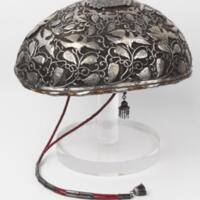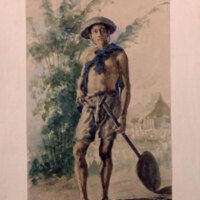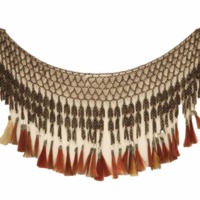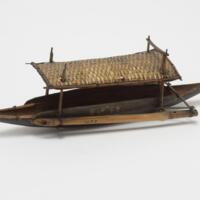Campilan sword
Text
Share this
Media
Images
Map National Anthropology Museum Madrid
Metadata
Publisher
National Anthropology Museum Madrid
Date
19th century
Identifier
CE1572
Origin
Mindanao (island), Philippines, Southeast Asia
Connection to Philippines
Maguindanao origin
Materials
blade: iron
handle: wood
rope: bejuco fibre
ornament: horsehair
techniques: blade: cast, hilt: carved
handle: wood
rope: bejuco fibre
ornament: horsehair
techniques: blade: cast, hilt: carved
Physical Dimensions
handle: length = 29 cm, width = 16 cm
sword: length = 110 cm
blade: width = 6.50 cm
sword: length = 110 cm
blade: width = 6.50 cm
Short description
Sword with iron blade and carved wooden handle. It is a heavy sword that had to be used with both hands. Its carved wooden handle evokes the open mouth of a naga, a fundamental decorative form among Muslim groups that symbolizes a serpent or dragon, and is also a male symbol; of Hindu origin, it is spread throughout Southeast Asia. This type of weapon is typical of the Moorish groups of Mindanao, mainly the Magindanao.
Acknowledgements
Photos by Javier Rodríguez Barrera and Arantxa Boyero Lirón
Collection
Cite this Page
“Campilan sword,” Mapping Philippine Material Culture, accessed April 20, 2024, https://philippinestudies.uk/mapping/items/show/28094.
Geolocation
Sensitive Content
Mapping Philippine Material Culture collates digital material from institutions, and some of this material is inherently colonial and contains words, terms and phrases that are inaccurate, derogatory and harmful towards Filipino and Filipino diasporic communities. Catalogue transcriptions, book titles, exhibition titles and museum titles may contain harmful terms. We recognise the potential for the material to cause physical and mental distress as well as evoke strong emotions. Owing to the scale of the collection’s data, a process to implement sensitive-content warnings in the displayed data is still incomplete. The material within the catalogue does not represent Mapping Philippine Material Culture’s views. Mapping Philippine Material Culture maintains a strong anti-colonial, anti-racist position and affirms its support for centring the humanity of historically marginalised and disenfranchised communities.
Facebook Twitter



